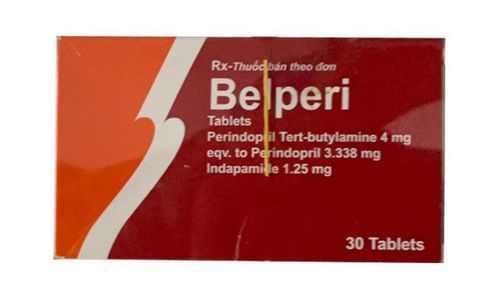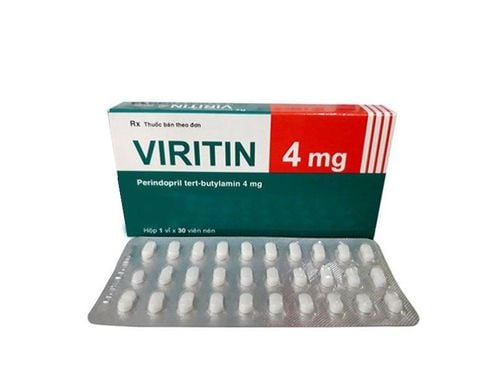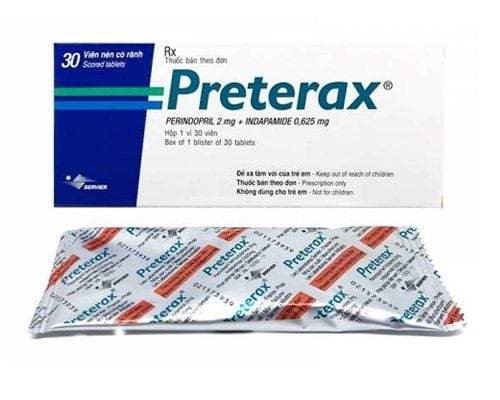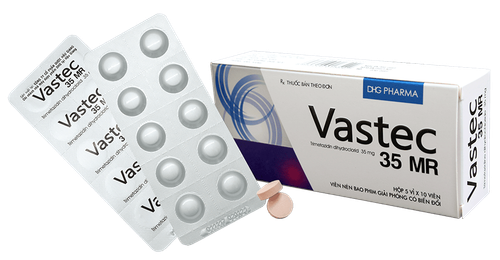This is an automatically translated article.
Bi Preterax drug belongs to the group of cardiovascular drugs, with the main ingredients being the active ingredients Perindopril, Indapamide and excipients just enough. So what does Bi Preterax do? Let's find out information about the drug through the article below.
1. What is Bi Preterax?
Bi Preterax drug belongs to the group of cardiovascular drugs. For the treatment of primary hypertension when blood pressure is not controlled with perindopril monotherapy.
Bi Preterax medicine contains the main ingredients including: Perindopril tert - butylamine equivalent to Perindopril 3,338mg and Indapamide 1.25mg.
Excipients include: Lactose monohydrate, magnesium stearate, hydrophobic silica colloid and microcrystalline cellulose.
Bi Preterax is made in the form of tablets, white, rod-shaped. The drug is packaged in a box of 1 blister, vial x 30 tablets.
2. What does Bi Preterax do?
Bi Preterax is a combination of 2 active ingredients Perindopril and Indapamide, creating a synergistic effect of lowering blood pressure, making the drug more effective than monotherapy. The mechanism of action of specific active ingredients is as follows:
Perindopril is an inhibitor of angiotensin converting enzyme II. As a result, the concentration of this substance decreases, thereby leading to: Increase in Renin activity combined with Bradykinin activation, decrease aldosterone secretion, vasoconstrictor effect, lower blood pressure in users. Indapamide is a diuretic. It has the effect of changing membrane permeability, reducing vascular smooth muscle contraction, stimulating PG synthesis, and vasodilators such as Bradykinin (a vasodilator) are also enhanced activity, helping to reduce blood pressure.
3. How to use Bi Preterax
3.1. How to use Bi Preterax For Bi Preterax, patients use it orally because the drug is in the form of tablets.
Take the drug in the morning and before meals, on an empty stomach for maximum absorption into the body.
3.2. Dosage of Bi Preterax The recommended dose of Bi Preterax for each specific case:
Usual dose: The dose is 1 tablet/time/day for adults. Elderly:
Patients can be treated after considering response to blood pressure and renal function. Patients with renal impairment:
In patients with moderate renal impairment with creatinine clearance between 30ml - 60ml/min, it is recommended to initiate treatment with an appropriate dose as a separate combination. In patients with creatinine clearance greater than or equal to 60ml/min, no dosage adjustment is required. Patients with severe renal impairment with creatinine clearance less than 30ml/min, the drug is contraindicated in this subject. Patients with liver failure:
Contraindicated in patients with severe liver failure. In patients with moderate hepatic impairment, no dose adjustment is required. Children and adolescents:
No recommendations for use. 3.3. How to handle when forgetting, overdosing Missed dose:
Regular daily use of antihypertensive drugs will be more effective. If you forget a dose of Bi Preterax, take it as soon as you remember within 1-2 hours of the prescribed time. If it is almost time for your next dose, skip the missed dose and continue taking it as prescribed. Do not use a double dose at the same time.
Overdosage:
Currently, the most common symptom of an overdose of Bi Preterax is hypotension, sometimes accompanied by nausea, vomiting, dizziness, drowsiness, mental confusion, decreased urination may be possible. progression to anuria, salt and water disturbances.
Measures to handle drug overdose:
Quickly eliminate the drug from the body by intestinal lavage or activated charcoal, then rehydrate and balance electrolytes. If hypotension is significant, place the patient in the supine position with the head lowered. An intravenous infusion of isotonic saline or other measures to increase volume may be considered if necessary. 3.4. Bi Preterax is contraindicated in the following cases:
Cases where the patient is allergic, sensitive to Perindopril, Indapamide or any of its ingredients. The patient had a history of Quincke's edema, associated with ACE inhibitors. Patients with severe hypokalemia. Uncontrollable decompensated heart failure. Severe liver and kidney dysfunction. Children and adolescents. Women who are in pregnancy from the fourth month onwards. Women are breastfeeding.
4. Notes when using Bi Preterax
4.1. Warnings and cautions when using Bi Preterax in patients Patients with collagen vascular disease, being treated with immunosuppressants, Allopurinol or Procainamide. Patients with electrolyte imbalance disorders, gout, diabetes. Patients with impaired liver and kidney function, atherosclerosis, especially renal artery stenosis. Elderly. The patient has impaired circulatory function. Women who intend to become pregnant or are pregnant: The use of Bi Preterax during the first trimester of pregnancy is not recommended. The drug is contraindicated from the fourth month of pregnancy. Lactation: The benefit to the mother and the risk to the infant should be weighed before a decision is made to discontinue nursing or discontinue Bi Preterax. Infants born to mothers taking the drug should be closely monitored. Driving and operating machinery: Side effects that may be encountered when using the drug include: dizziness, dizziness, headache. Users should consider the effects of the drug on their ability to work. Athletes: Drugs containing active ingredients that may produce a positive anti-doping test. 4.2. Side effects when using Bi Preterax The side effects when using Bi Preterax have been observed during treatment and are classified according to the following frequency:
Common:
Hypotension. Constipation, dry mouth, epigastric pain, loss of appetite, taste disturbance, dyspepsia, diarrhea. Skin rash, maculopapular rash. Asthenia. Dizziness, dizziness, headache. Tinnitus. Cramp. Uncommon:
Renal failure. Edema of face, extremities, lips, tongue, glottis or larynx, purpura Exacerbation of the patient's previous condition with diffuse systemic lupus erythematosus. Bronchospasm. Rare, very rare:
Thrombocytopenia, basocytopenia or neutropenia, hemolytic anemia, non-regenerative anemia. Arrhythmias including sinus bradycardia, supraventricular tachycardia, angina attacks, and myocardial infarction may occur secondary to patients at risk for excessive hypotension. Eosinophilic pneumonia, pancreatitis, hepatitis with hepatocellular destruction or cholestasis. 4.3. Interactions, drug incompatibilities Bi Preterax It is not recommended to use concomitantly Perindopril and Indapamide with Lithium. Increases side effects or may increase the risk of overdose and toxicity in patients because this drug reduces the elimination of Lithium.
Special caution when used concurrently with Baclofen, imipramine-like antidepressants, tranquilizers, corticosteroids, tetracosactide: risk of affecting the ability to lower blood pressure.
Concomitant use of other antihypertensive agents with perindopril or indapamide may cause a sudden, dangerously dangerous drop in blood pressure.
Do not use in combination with drugs that increase blood potassium such as potassium-sparing diuretics or potassium salts.
4.4. Storage of Bi Preterax medicine Store the medicine at a temperature not exceeding 30°C, avoid direct sunlight, avoid moisture, keep in a cool and dry place.
Keep out of reach and sight of children.
Do not dispose of medication through sewage or household waste.
Above is all necessary information when using Bi Preterax medicine. Bi Preterax is a prescription drug, patients need to strictly follow the doctor's instructions to achieve the highest effectiveness during treatment. Hopefully, the article has provided all the necessary notes for readers when using Bi Preterax.
Please dial HOTLINE for more information or register for an appointment HERE. Download MyVinmec app to make appointments faster and to manage your bookings easily.













